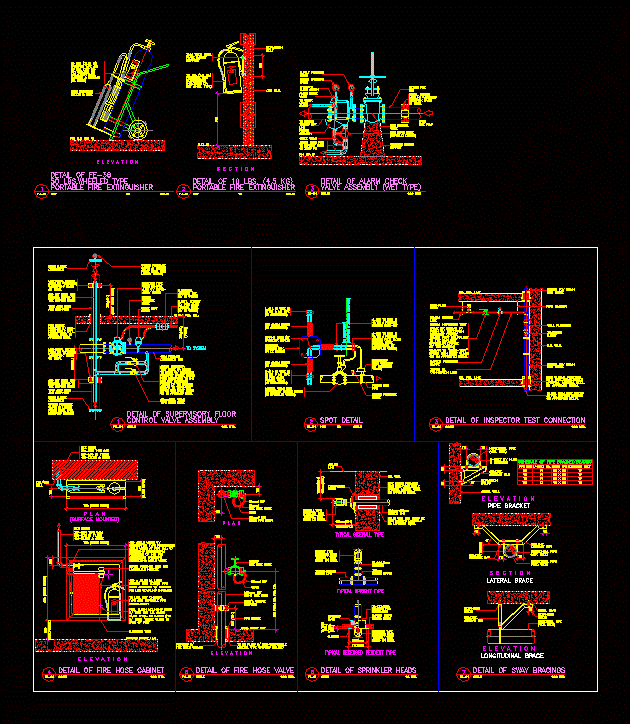
This way, the builder can give the designer the specifics regarding the underground distances and allow the technician or engineer to determine the most appropriate pipe size. Ideally, a sprinkler system design will be completed before supply lines are in place. Large underground supply lines to houses allow for smaller and less complicated sprinkler lines, which reduce material and labor costs.

The supply line determines how much money any given sprinkler system will cost the sprinkler installer, builder and homeowner. Verifying the size and distance of the water supply line to the home is thus indispensable to appropriately planning a system. The flow required to meet this pressure will change depending on the size of the sprinkler orifice, but for a typical residential sprinkler that flow will be 13 gpm (gallons per minute).
#HOW TO QUOTE A FIRE SPRINKLER DESIGN INSTALL#
The more complicated the system, the more labor will be required to install it.įortunately, the above determinants, and thus the costs, can be limited during the design process by considering underground water supplies, builder techniques and design techniques.Īccording to NFPA 13D, the minimum pressure requirement for a standard residential fire sprinkler head is 7 psi (pounds per square inch). Installation time: Labor can add considerable cost to a fire sprinkler system.Number of sprinkler heads: The more sprinkler heads required in a home, the higher the material costs.Pressure losses: Depending on how much pressure is lost in a home’s supply pipes, this problem can mean increased meter sizes or supply-pipe diameters, or even costly storage tanks and pumps.With states like California and Maryland, along with other municipalities nationwide, officially adopting these standards and requiring fire sprinkler systems in all new one- and two-family homes, builders have no choice but to face the costs head on.įire sprinkler system costs have three main determinants: NFPA Standard 13D, developed in 1973, affects one- and two-family dwellings, manufactured homes and townhomes and aims to prevent flashover, or the explosive ignition of flammable gases released by burning materials in the home. NFPA Standard 13R, developed in 1989, governs detection and control of fires in multifamily residential buildings and residential occupancies up through four stories in height. As a result, they are gradually adopting National Fire Protection Association (NFPA) standards that govern fire sprinkler installation. In recent years, however, state and local governments have increasingly come to recognize fire sprinkler systems’ value. This hesitance to incorporate fire sprinklers largely results from the cost, which ranges between one and two dollars per square foot for residential systems. Yet, historically, fewer than two percent of new homes include them. Residential fire sprinkler systems can save lives as well as prevent financial, physical and emotional damage. Fortunately, several steps in the design process, if undertaken early enough, can minimize the financial sacrifice. C&M Sprinkler Design is always aiming for the optimum fire protection solution to create systems that are easy to install, cost-effective, and code-compliant for every client.Ĭ&M’s in-house designers maintain a current library of NFPA and Factory Mutual standards, International Building Codes, and other key materials to stay on the cusp of newly updated information.Ĭontact C&M Sprinkler Design today and let us take your projects to the next level.Increasing mandates to include fire sprinkler systems in new residential construction are naturally affecting bottom-line costs. We take an innovative approach to designs using fundamental physics, common sense, and up-to-date technology that provides contractors with all of the information they need in an easy-to-understand format.

C&M is proud to offer the knowledge, skills, and experience necessary to succeed in any scenario.Ĭontractors can save time, money, and internal resources by outsourcing fire sprinkler design and drafting services to experienced firms. With the ever-changing needs of clients, building owners, and their facilities, we strive to provide prompt, thorough, and competitively priced designs for any situation. We are focused on merging the latest technologies with client desires and requirements to create the ideal design for the project at hand.Ĭ&M Sprinkler Design offers a wide range of design and drafting services across the fire protection industry. From the simplest single-family dwelling unit to rack storage systems beyond NFPA 13 standards, C&M Sprinkler Design is dedicated to providing cutting-edge designs that suit the needs of each individual client.


 0 kommentar(er)
0 kommentar(er)
